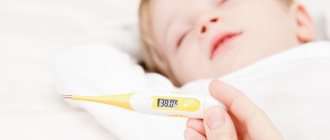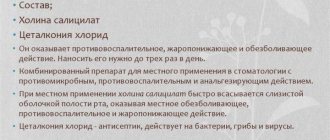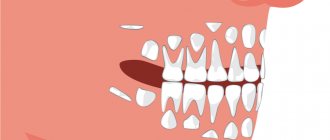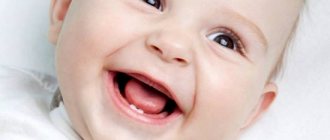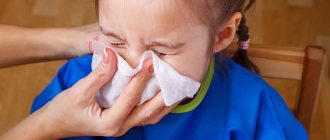When snot appears in a baby, when other signs such as fever, cough, red throat are absent, we can say that the cause is a runny nose during teething. After the teeth appear, the snot usually disappears. During this period, the baby's immune system is weakened, which can cause a risk of contracting a viral infection.
- The connection between runny nose and teething
- Causes of runny nose during teething in children
- Signs of snot in a child
- Features associated with ARVI
- How to help a child
- What parents should not do when treating snot during teething in children
Main symptoms of teething
The eruption of baby teeth is often a real test for children and their parents. In most cases, this is accompanied by many unpleasant symptoms:
- redness and swelling of the gums with the greatest intensity in the eruption zone;
- pain that gets worse at night and in the morning;
- increased temperature;
- moodiness, anxiety;
- runny nose and nasal congestion;
- cough;
- diarrhea.
It is extremely rare for children under one year of age to experience the teething process easily. Even if the first teeth come out asymptomatically, you cannot be completely sure that unpleasant signs will not appear in the future. Therefore, parents need to know how to alleviate the child’s condition.
What to do
If the baby has a runny nose during teething, parents should take the following measures to help navigate the situation:
- organize control over the child’s condition;
- ensure optimal temperature in the room (18–20 degrees), ventilate more often;
- monitor the humidity level in the nursery (optimal – 50–70%);
- Give the baby plenty of water (daily volume of liquid – 1.5–2 liters);
- maintain a daily routine;
- use fortified products;
- walk in the fresh air more often;
- If the child’s well-being worsens, do not neglect medical help.
Following the above tips will help you safely survive snot on your teeth and will not allow bacteria and viruses to penetrate the weakened child’s body.
The eruption of teeth in a baby or the development of an infectious disease can be judged based on the duration of the baby’s pathological condition.
Signs of snot in a child
Symptoms of snot on teeth are:
- increased salivation,
- the child does not sleep well,
- the baby's appetite has decreased,
- diarrhea appeared.
During teething, the baby's temperature may rise . This is explained by a large accumulation of active components. If the temperature rises above 38 and lasts more than three days, parents should definitely contact their pediatrician.
A baby’s snot may also be accompanied by a cough. A large amount of mucus forms in the child’s mouth, which, when it gets into the back of the throat, irritates it and causes a cough. In this case, you also need to make sure that the cough is not caused by a virus, but is associated with teething.
Other phenomena accompanying teething
During the dental period, a baby may not only have snot, but other manifestations are also possible. The main one is swollen gums, on which hematomas sometimes appear.
Most often, a complex of symptoms occurs - the temperature rises, the child begins to wheeze and cough. Some babies react to teething with increased excitability, sleep disturbances and appetite disturbances.
In some cases, parents do not notice the beginning of the dental process at all, and the mother stumbles upon the first tooth with a spoon when introducing complementary foods.
How and with what to treat a runny nose during teething?
Is it necessary to treat a runny nose during teething in young children? First, make sure that the mucus is caused by a tooth and not an infection. Most often, such a runny nose goes away on its own. To alleviate the child’s condition, ensure comfortable air humidity in the room and make sure that the air temperature in the children’s room does not exceed 22 degrees.
To treat a runny nose, you should not use vasoconstrictor drops or other medications without a doctor’s prescription. Snot during teething in infants is safe and for treatment it is enough to regularly rinse the nose with saline solution (Aqualor Baby, Otrivin Baby, Aquamaris).
Dental gels (Kalgel, Dentokind, Kamistad) are used to relieve swelling of the gums. When using them, strictly adhere to the dosage. To relieve pain, you can give medications based on Ibuprofen. Just don't abuse it.
We suggest you read: What is the cause of blockages in the tonsils and is it possible to get rid of them yourself at home? - So that your throat doesn't hurt
They are allowed to be used no more than 3 times a day for 3 days.
If you notice that mucus is preventing your child from breathing, rinse the nose with saline solution and clear the nasal passages.
These actions should be done regularly to prevent dried crusts from forming in the nose. If this happens, breathing will worsen and the baby will experience discomfort.
Important! Do not use nasal rinsing solutions in the form of sprays. They are allowed to be used only for children over 5-6 years old. In infants, the spray can cause ligament spasms. It is safer to use drops for children.
If a child has a cold, the pediatrician prescribes treatment. In most cases, the following treatment regimen is used:
- antiviral drugs - Viferon, Ergoferon, Imupret, Amiksin;
- antitussive syrup - Lazolvan, Ambroxol, Sinekod;
- tablets and spray to relieve inflammation in the throat - Miramistin, Lisobakt.
What is snot like when teething, and how long does a runny nose last?
Inflammation and redness of the gums, swelling of the soft tissues of the oral cavity, and the appearance of pain almost always affect the condition of the nasal mucosa, because they are closely interrelated. Therefore, moderate or occasional nasal congestion is considered a fairly common symptom of the growth of baby teeth.
During the period of active teething, clear, watery mucus begins to secrete from the baby’s nose, which brings him virtually no discomfort. In this case, there may be slight congestion and a wet cough. The symptoms are caused by increased blood circulation in the nasal mucosa and nasopharynx.
Additionally, salivation is activated: mucus flows down the back wall of the nose and accumulates in the throat, causing periodic coughing. Read more about teething cough→
It is important to distinguish between signs of teething and symptoms of the disease.
| Symptom | During teething | For a viral infection |
| Runny nose | Slight, mucous, transparent nasal discharge that does not cause discomfort to the child. In most cases, they stop after the teeth erupt. May be present for a long time during active tooth growth | Copious discharge of mucus from the nose, which changes in character after a certain time. Thickening of the mucus is noted, its color changes - the discharge becomes yellow or yellow-green |
| Nasal congestion | Moderate or intermittent nasal congestion may occur due to slight swelling of the mucous membrane. Congestion is caused by the accumulation of mucus in the nasal passages and their slight swelling as a result of increased blood circulation | There is severe nasal congestion, which intensifies as the production of thick mucus is activated, with little relief after clearing or suctioning the secretions. The appearance of constant sniffling and grunting. The child becomes restless and sleep is disturbed. Removing mucus provides only short-term relief |
| Cough | Rare cough | A dry, persistent cough, which in most cases is caused by redness of the throat and/or swelling of the vocal cords. Possible occurrence of hoarseness, distant wheezing, cough, shortness of breath |
| Temperature increase | Only during the period of active tooth growth, decreases after eruption | Persistent temperature reaction up to febrile levels |
| Presence of other signs of disease | There may be a slight looseness of stool, moodiness, sleep disturbances and decreased appetite during the period of active teething. | The baby is lethargic, drowsy, refuses to eat and drink, and all clinical signs of the disease are worsening |
Runny nose in a baby during teething: main causes
Almost everyone will have painful teething, this situation cannot be avoided. But knowing the symptoms and the reasons for their appearance, parents can make life much easier during this difficult period for both themselves and their baby.
Let's take a closer look at why many children also develop a runny nose when their first teeth appear.
The mucous membranes of the nose and mouth are located quite close. Due to the fact that mild inflammation begins in the mouth, the nasal mucosa is also irritated. The body reacts to this instantly, starting to produce phlegm (“snot”) in order to calm the irritation or get rid of what may be causing it.
In addition, increased irritation of the nasal mucosa occurs due to the fact that blood enters both the nose and mouth through the same arteries. Blood circulation in the oral cavity during teething becomes more active, and the same processes occur in the nasal mucosa. And the more active the blood circulation, the more mucus the mucosal glands will produce.
A runny nose may occur due to a mild cold. It is during the period when the first teeth are cut that the first complementary foods are introduced, the dose of breast milk is reduced, and the body undergoes restructuring. Also, the baby constantly tries to chew something to relieve itching from the gums, and the path for viruses and microbes into the small body is open. Fortunately, the baby has enough resources to fight off a cold. A slight runny nose is its residual effects.
It is precisely because of reduced immunity and changes in the child’s eating behavior that a runny nose can also signal allergic reactions. At the same time, it is important to monitor whether the child has any other manifestations of allergies. You should be alerted to a rash, itching, and redness of the mucous membranes of the eyes.
If the baby remains active during the teething period, it is likely that due to his active movements, part of the saliva, which is secreted more than abundantly during this period, ends up in the nose. And it comes out of it in the form of transparent, light snot.
What symptoms accompany the teething period?
Sometimes it is difficult for a mother to understand which signs of teething are normal for the baby and which are not. Each baby reacts differently to the growth of baby teeth. Some will develop a high fever and runny nose, swelling of the gums, while others will endure this period painlessly.
Normally, teething begins at 4-8 months. The age at which primary teeth appear depends on many reasons, including heredity, nutritional habits and systemic diseases. By middle school, the baby set of teeth will be replaced by permanent ones, which will remain with the person for the rest of his life.
The eruption of the first teeth is often accompanied by unpleasant symptoms:
- swelling, swelling of the gums;
- the appearance of white bubbles or small blue hematomas on the gums;
- increased salivation;
- desire to chew, scratch gums;
- severe pain, as a result of which the baby cries, screams, and often wakes up at night;
- coughing caused by excessive salivation;
- runny nose with clear discharge without foreign impurities;
- an increase in body temperature to 38°C for 2-3 days;
- anxiety, irritability;
- the baby is fiddling with his ears - the pain from the tooth can radiate into them;
- appetite and sleep disorders;
- red rash around the mouth due to skin irritation from saliva;
- the baby sniffles in his sleep;
- occasional cases of diarrhea.
We invite you to familiarize yourself with Non-carious dental lesions – Diagnosis and treatment of non-carious dental diseases – dental portal
Based on these signs, we can conclude that the child’s first tooth will soon come out.
When should you see a doctor?
A runny nose during teething is usually mild - the child’s snot is clear, and the duration of the illness is limited to several days. However, in some cases, in order not to aggravate the problem, it is necessary to consult a doctor. Let's look at what symptoms should alert parents and when to see a specialist:
- rhinitis lasts longer than a week;
- body temperature exceeds 38 degrees;
- the child is lethargic or very agitated and has poor appetite;
- snot has a thick consistency and has a yellow-green tint;
- blood streaks are noticeable in the nasal discharge;
- severe cough, hoarse voice;
- the baby cries if his mother touches his ear;
- pus is discharged from the child’s ears;
- the baby does not get better after 3-4 days.
Until the child leaves infancy, the pediatrician should be informed about all changes in his health and behavior.
You should visit a doctor as soon as possible if:
- cough occurs in attacks;
- accompanied by audible wheezing;
- purulent sputum is rejected;
- the child refuses to eat and drink;
- temperature rises beyond 38℃;
- antipyretics do not help;
- Vomiting or severe diarrhea occurs.
You need to visit the pediatrician again if the cough and other signs of teething do not disappear for more than 6-7 days. A child may get sick after symptoms appear, and parents will think that it is because of the teeth.
Features associated with ARVI
If snot appears on the teeth, parents need to consult a pediatrician or understand that there are no reasons for concern. Komarovsky believes that a runny nose during teething cannot always be treated.
Viral runny nose can be characterized by the following reasons:
- a child, even before the causes of the disease appear, becomes lethargic, his appetite worsens, weakness and pain in the muscles may be observed,
- an increase in body temperature to high values. Although a temperature may be observed during teething, the fever is more pronounced with the virus. If the cause is teeth, then after a few days the temperature disappears without a trace,
- snot, dry or wet cough can be the cause of upper or lower respiratory tract disease. A dry or wet cough that does not go away within three days is possibly viral in nature. Komarovsky believes that teeth in combination with a cough can be the cause of the disease, and hard breathing without wheezing is a residual symptom of a previous viral disease,
- An infectious runny nose is accompanied by impaired nasal breathing and a large amount of mucus secreted. With a virus, the discharge can be mucopurulent, but when it erupts, it is usually transparent.
Treatment of children: Komarovsky
A runny nose during teething, with proper care of the baby, can be treated without serious medications.
What to do to help your child recover in a short time:
- If your nose is stuffy, use narrowing drops for six days;
- Drink plenty of fluids. Tea with raspberries is especially useful;
- It is very important to humidify the air and maintain a normal indoor temperature. Drying of the nasopharynx cavity leads to the formation of crusts. In this case, the child experiences nasal congestion;
- There is no need to force your baby to eat;
- Bed rest should be observed.
Recommendations by Evgeniy Komarovsky state that frequent exposure to fresh air, physical exercise, proper nutrition and taking a vitamin complex will help avoid the unpleasant manifestations of a cold.
If you have high cholesterol, read the article: Choledol: doctors’ opinion, divorce...
If you are looking for Lipocarnit weight loss capsules, look here, because Lipocarnit is sold only on the official website.
How to help a child
A runny nose during teething, as Dr. Komarovsky explains, needs to be treated for inflamed gums. To do this, you can use anti-inflammatory gels - Kamistad and Kalgel. If the symptoms do not disappear for a long time, then the child can be given antiviral drugs approved for teething.
In order for your baby to recover faster, he needs:
- use narrowing drops for no more than six days,
- give plenty of fluids to drink, especially raspberry tea,
- it is necessary to maintain optimal air temperature and humidity in the baby’s room,
- do not force him to eat if the child has no appetite,
- If necessary, maintain bed rest.
To alleviate a child’s condition with a runny nose and snot, he can be helped as follows:
- rinse the nose with saline solution to relieve inflammation and remove mucus,
- use an aspirator to remove mucus,
- If your nose is stuffy, you can use drops to relieve swelling of the nasal mucosa.
Drops that can be used by children when teething are Otrivin, Nazivin and Aqualor.
You can constantly rinse your child’s nose with saline solution several times a day, because it is harmless and has no contraindications.
Sometimes the contents of the child’s nasal sinuses dry out, full access to breathing ceases and moisture occurs. To prevent the occurrence of a runny nose, it is necessary to avoid the appearance of dry crusts.
To prevent dry crusts in a child, you need to:
- rinse thoroughly and constantly moisturize your nose,
- prevent the appearance of mucus with special preparations.
Can a baby develop snot when teething?
A runny nose during teething is a common occurrence. It is important for the pediatrician and parents to identify its cause. In case of an infectious disease, the nature of the discharge will be different in consistency and color. When you have a cold, snot changes from clear liquid to thick with a yellow or green tint.
A small amount of clear mucus is completely normal during teething. There is no need to treat such a runny nose - it will go away on its own in a few days, when the swelling of the gums subsides.
Answered by Komarovsky E. O.
Teething is very often accompanied by a runny nose, and any practicing pediatrician can confirm this. The described phenomenon is usually explained by the fact that the process of teething is often accompanied by a decrease in local immunity, and this in turn significantly increases the likelihood of a viral infection. However, quite often a runny nose during teething cannot be explained by any viruses. The child’s condition is not disturbed, there is no increase in body temperature, an excellent appetite, and all that is there is, as you write, “transparent snot, not very much,” and plus teething. Again, such a runny nose can last for weeks, which is at least not typical for an acute viral infection. There is, apparently, another mechanism for a runny nose during teething. The blood supply to the gums and nasal mucosa is closely related anatomically. When teething, blood circulation in the gums is activated, and this inevitably leads to increased blood supply to the nasal cavity. The consequence of the latter is more active work of the glands of the mucous membrane. Hence the additional mucus - transparent and in small quantities. As in your example. So a moderate runny nose during teething with normal body temperature and undisturbed general condition may well be considered as a variant of the physiological norm. Inflammatory processes affecting the airways, especially the bronchi, almost always change the volume of exhalation - it can be heard just as well as inhalation. Such breathing, in which the volume of inhalation and exhalation is the same, is called hard. Thus, the doctor can hear hard breathing when the bronchial mucosa is inflamed (with bronchitis), as well as in a situation where there is dry mucus on the surface of the bronchi: this mucus makes the inner surface uneven, so breathing noise occurs both when inhaling and exhaling. If there was a lot of mucus, if it accumulated in the lumen of the bronchi, then the doctor would definitely hear wheezing. There is no wheezing - not a lot of mucus, “feels good” - serious inflammation in the bronchi is extremely unlikely. Most likely, both cough and hard breathing are residual manifestations of a previous acute respiratory viral infection, caused by the presence of dried mucus on the surface of the bronchi. It's not dangerous, time and fresh air heal it. Walk a lot, moisten and ventilate the children's room, don't be nervous and don't beg for medicine. All answers
Is it possible to prevent the appearance of a runny nose during teething?
It is impossible to prevent the appearance of a runny nose during teething, as well as to predict the baby’s body’s reaction to this event. Parents can carry out nonspecific prevention of respiratory diseases and improve the child’s health:
- strengthen the immune system (frequent walks, airing the room, playing sports, hardening);
- create a complete baby food diet, rich in vitamins and microelements, according to age;
- breastfeed your baby for as long as possible;
- observe the temperature regime, avoid overheating or hypothermia;
- administer vaccinations according to the National Vaccination Calendar;
- regularly wash pacifiers and toys that the baby puts in his mouth;
- during the period of teething, do not visit crowded places to avoid infection with respiratory diseases;
- give drinks as much as the child wants, apply to the breast as required;
- If a disease is detected, be sure to consult a doctor and avoid self-medication.
We suggest you familiarize yourself with how many teeth an adult should have, the number of molars (permanent) teeth is normal
Causes of runny nose during teething in children
A newborn’s first teeth appear between 4 and 7 months of life; usually by the age of three they fill the child’s entire mouth. During this period, the baby is introduced to the first complementary foods and the proportion of breast milk decreases, which leads to a weakening of the child’s immunity . After all, milk contains a large number of antibodies, because they protect the baby from viruses.
The period when teeth are cut becomes difficult not only for the baby, but also for the whole family. The child becomes restless, cries and constantly puts foreign objects into his mouth. In addition, the baby develops a runny nose .
Normal condition of snot
A runny nose is one of the symptoms of an emerging disease. If a severe runny nose is observed during teething, this indicates the presence of an infection. The child should be seen by a doctor when there is excessive mucus secretion.
A visit to the doctor is also necessary if your child's nose is stuffy. The baby's breathing is impaired due to the accumulation of mucus. The snot forms a plug and the baby cannot breathe. These symptoms indicate the presence of an infection that requires treatment.
When teething, it is normal to have a slight mucus discharge from the nose. The mucus should be transparent, which is released for 3-5 days. The presence of yellow or green shades in the mucus indicates infection.
When cutting through, you should also pay attention to the duration of nasal congestion. In normal condition, the nose will be blocked in the aisles for 5 days. You should consult a doctor if your nose is stuffy for more than 5 days.
Swelling of the mucous membranes
Teething in almost all cases is accompanied by swelling of the gums, from which an incisor or canine will soon emerge. However, in children under one year of age, redness and swelling can be observed not only on the gums, but also on the mucous membranes of other organs.
Sometimes the walls of the nasal passages, the inner surface of the cheeks, the palate, and the throat become swollen and sensitive. It happens that swelling occurs only on one side - where the tooth will soon erupt.
All this bothers the baby, makes breathing difficult, and interferes with normal swallowing.
Causes of the phenomenon
Parents often notice that if a child begins to teethe, then liquid snot flows from the nose. A doctor who is approached with such a problem gives one answer: a runny nose is a viral phenomenon.
But an increase in the amount of mucus in the nasal cavity is not always associated with bacterial microflora. There are a number of reasons why a runny nose appears during teething:
- Local immunity decreases as the tooth grows. Therefore, a one-year-old child becomes vulnerable to disease.
- A stuffy nose during tooth growth is associated with the special physiological structures of the nasopharynx of babies.
- If a doctor insists on therapy, then this is correct, because this is his professional duty. For a baby, each type of respiratory disease can lead to complications such as bronchitis. The task of doctors is to warn against serious consequences. Most often, pediatricians stimulate the child’s body with interferon.
- Determining whether a child is teething is quite simple - look in his mouth. In the area where the tip of the tooth should appear, the gums expand, and if you run your finger over this area, you can feel the hard crown.
In addition, a few days before the tooth is completely exposed, a white dot will be visible on the gum surface. Some parents confuse this phenomenon with signs of stomatitis. However, after just a day, it becomes clear that the spot has become wider and transformed into a hole from which a tooth can be seen.
Causes of teeth grinding in children
In medicine, the condition when a child grinds his teeth is called bruxism. The first symptoms appear in infants during teething, but then they gradually fade away. Signs of bruxism can appear in kindergarten and after entering school. But by the age of 6-7 years, the majority of involuntary teeth grinding disappears.
Inexperienced parents associate the appearance of unpleasant sounds with worms. But studies show that the presence of helminths does not affect the occurrence of squeaking. Why some people associate these two conditions with each other is unknown. Perhaps the culprit is the proliferation of worms, which are able to migrate through the oropharynx, or night itching of the anal area caused by crawling females.
The cause of teeth grinding needs to be looked for elsewhere. In an infant, this is associated with teething. More often, the problem appears in the eighth month and later, when several teeth have appeared on the upper and lower jaw. The baby has an immature nervous system, and the baby incisors irritate the nerve fibers adjacent to them - salivation increases, and the jaw muscles spasm. But creaking in infants is not pronounced and lasts a few seconds. Some experts believe that the problem appears due to a strong pain impulse.
Children one year of age and older grind their teeth for another reason:
- Incorrect bite - when the jaw is formed incorrectly, the position of the teeth is disturbed, the load on the muscles is redistributed, so creaking may occur at night and during the day.
- Heredity - parents may have a tendency to bruxism and periodically grind their teeth, so this symptom will also appear in the child.
- Calcium deficiency can occur in a one-year-old child and at an older age. Calcium is necessary for muscle contractions; its lack causes spasms. Sometimes this is a local convulsive tension of the jaw muscles.
- Nervous stress – this cause of bruxism is typical for preschoolers and primary schoolchildren. Computer games, traumatic situations, watching TV before bed, and even going to kindergarten or school for the first time have an irritating effect.
- Dental reasons are incorrectly performed fillings that rise above the crown of the tooth and do not allow the jaw to close, as well as pathologies of periodontal tissue or the temporomandibular joint.
Children with certain pathologies of the nervous system may grind their teeth during the daytime. Sometimes this is the first sign of a special form of epilepsy, which manifests itself in the form of local short-term muscle spasms, rather than seizures throughout the body.
A baby whose jaws are growing quickly, but they do not have enough load, can grind their teeth. Therefore, from 4-5 months they are given smooth, hard teethers, vegetables and fruits to chew on.



